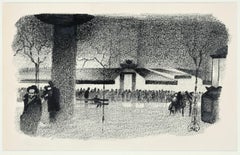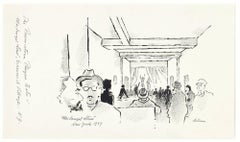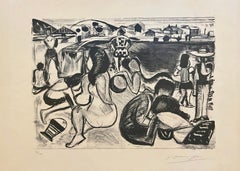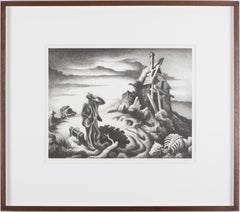Adolf Hallman Prints and Multiples
1893-1968
Adolf Hallman was a Swedish illustrator who sensibly contributed to Swedish, Danish and Norwegian newspapers and magazines, including Tidens Tegn, Dagbladet, Exlex and Politiken. På Boulevard Europa is one of his famous books. He illustrated editions of Charles Baudelaire's book Fleurs du Mal and Guy de Maupassant's book Boule de Suif.
to
1
2
Overall Width
to
Overall Height
to
3
1,183
938
886
817
2
1
1
2
2
2
1
1
1
1
1
1
1
2
Artist: Adolf Hallman
Quartier Latin - Lithograph by A. Hallman - 1930s
By Adolf Hallman
Located in Roma, IT
Latin District is a beautiful original lithography artwork on ivory-colored paper, made by the Swedish illustrator and reporter Adolf Reinhold Hallman in 1930 ca.
The state of pres...
Category
1930s Adolf Hallman Prints and Multiples
Materials
Lithograph
$414 Sale Price
30% Off
Provincetown Players - Original Monotype Lithograph by A. Hallman - 1959
By Adolf Hallman
Located in Roma, IT
Provincetown Players is a beautiful black and white lithograph on "C. M. Fabriano" watermarked paper, made by the Swedish illustrator and reporter Adolf Reinhold Hallman in 1959. The state of preservation is excellent. On the back the blue ink stamp "Made in Italy by Adolf Hallman, 54 Via Margutta Roma". at the center of the sheet. Including a white cardboard passepartout, cm 34 x 49.
On the lower margin and on the right margin there are black ink hand-written notes, inside the image, the date and the signature “Hallmann”.
The inscription that gives the title to the artwork refers to the American theatrical organization began performing in 1915 in Provincetown founded by a nontheatre group of writers and artists whose common aim was the production of new and experimental poetry.
In 1916 the group produced in New York City Eugene O’Neill’s Bound East for Cardiff and Thirst, thus launching the career of one of America's distinguished playwrights. So Provincetown Players took up residence in New York City’s Greenwich Village, as Hallman reports on lower margin, and for years thereafter discovered and developed the work of such noted writers, designers, and actors as Donald Oenslager, Kenneth Macgowan, Jasper Deeter, and Paul Green...
Category
1950s Adolf Hallman Prints and Multiples
Materials
Monotype
Related Items
Untitled abstract seaside, original lithograph
By François Desnoyer
Located in Belgrade, MT
Pencil signed black and white lithograph original limited edition pencil signed , Guilde De La Gravure. Mid 20th Century, part of my private collection. Very Good condition.
Category
Mid-20th Century Cubist Adolf Hallman Prints and Multiples
Materials
Lithograph
$636 Sale Price
33% Off
H 13 in W 15 in
Prodigal Son
By Thomas Hart Benton
Located in London, GB
A man raises his hand to his chin, his neck tilted and face turned to look at a dilapidated farmhouse, barely held together by planks of wood and exposed to the elements. Behind him ...
Category
1930s American Modern Adolf Hallman Prints and Multiples
Materials
Lithograph
Clemente Untitled B: surreal mythical landscape, voyage with ocean, Venus, snake
By Francesco Clemente
Located in New York, NY
A black and white, large-scale surreal mythical landscape of an ocean voyage, with a snake wrapped around a clock, a ship, Venus sculpture, greek urns, and snakes, printed in black o...
Category
1980s Contemporary Adolf Hallman Prints and Multiples
Materials
Lithograph
$2,975
H 26.75 in W 119.25 in
"Winch" British Linocut Grosvenor School Machine Age 1930 Woman Artist Print
By Sybil Andrews
Located in New York, NY
"Winch" British Linocut Grosvenor School Machine Age 1930 Woman Artist Print
"The Winch" 1930. 7 3/4 x 11 (sight) inches. Linocut in colors on tissue...
Category
1930s Modern Adolf Hallman Prints and Multiples
Materials
Linocut
$59,000
H 15 in W 18 in D 1 in
Vintage David Hockney Exhibition Poster Ashmolean Museum 1981
By David Hockney
Located in New York, NY
Poster produced for David Hockney’s 1981 exhibition at The Ashmolean Museum, Oxford, which displayed the sets and costumes he designed for the Glyndebourne Festival Opera’s 1975 prod...
Category
1980s Modern Adolf Hallman Prints and Multiples
Materials
Offset
“Thebes, Great Hall at Karnak”
By David Roberts
Located in San Francisco, CA
This lithograph titled "Thebes, Great Hall at Karnak" is a notable work by the Scottish painter David Roberts (1796-1864). This particular scene is part of Roberts' most famous colle...
Category
1840s English School Adolf Hallman Prints and Multiples
Materials
Paper, Lithograph
'Jesus and the Woman at the Well, ' by Amand-Durand, Engraving
By Armand Durand
Located in Oklahoma City, OK
This early 19th century framed 35" x 31" engraving by artist Amand-Durand depcits an etching of 'Jesus and the Woman at the Well,' after the Dutch master, Rembrandt van Rijn. This poignant Biblical story is depicted by Arman-Durand in Rembrandt style...
Category
Early 19th Century Old Masters Adolf Hallman Prints and Multiples
Materials
Engraving
$1,200 Sale Price
20% Off
H 30.5 in W 26.5 in D 1.5 in
Down the River
By Thomas Hart Benton
Located in London, GB
In this sentimental work from 1939, Benton expresses his admiration for the rural lifestyle of the Midwest. He highlights the connection between man and the land by depicting two fig...
Category
1930s American Modern Adolf Hallman Prints and Multiples
Materials
Lithograph
“Winter” from the “Four Seasons Suite” Series
By Alvar Sunol Munoz-Ramos
Located in San Francisco, CA
This embossed, numbered and signed lithograph, part of the “Four Seasons Suite,” is by Alvar Suñol Muñoz-Ramos (b. 1935), a renowned Spanish ar...
Category
1970s Modern Adolf Hallman Prints and Multiples
Materials
Paper, Lithograph
$1,350
H 37.25 in W 30.5 in D 2 in
Inside the castle by David Hockney (Six Fairy Tales from the Brothers Grimm)
By David Hockney
Located in New York, NY
From David Hockney’s celebrated Six Fairy Tales from the Brothers Grimm portfolio, an image of the story ‘The boy who left home to learn fear’. Hockney chose this story for its obscu...
Category
1960s Modern Adolf Hallman Prints and Multiples
Materials
Etching, Aquatint
$2,250
H 17.75 in W 16 in
Vintage David Hockney Poster Miami New World Festival of Arts 1982 palm trees
By David Hockney
Located in New York, NY
This vintage David Hockney poster features whimsical imagery and rich, bright color. Palm trees, boats in the ocean, a cafe, and a bodega with an elaborate iron-wrought balcony sit a...
Category
1980s Realist Adolf Hallman Prints and Multiples
Materials
Lithograph
"Labor in a Diesel Plant" Machine Age American Scene Industrial Mid 20th Century
By Letterio Calapai
Located in New York, NY
"Labor in a Diesel Plant" Machine Age American Scene Industrial Mid 20th Century
Letterio Calapai (American 1902-1993)
''Labor in A Diesel Plant''
Wood engraving, 1940
17 x 10 1/2...
Category
1940s American Modern Adolf Hallman Prints and Multiples
Materials
Lithograph
$6,900
H 23 in W 16 in D 2 in
Adolf Hallman prints and multiples for sale on 1stDibs.
Find a wide variety of authentic Adolf Hallman prints and multiples available for sale on 1stDibs. You can also browse by medium to find art by Adolf Hallman in lithograph, monotype and more. Not every interior allows for large Adolf Hallman prints and multiples, so small editions measuring 14 inches across are available. Customers who are interested in this artist might also find the work of Benjamin Thomas Taylor, Arthur William Heintzelman., and Charles Camoin. Adolf Hallman prints and multiples prices can differ depending upon medium, time period and other attributes. On 1stDibs, the price for these items starts at $418 and tops out at $437, while the average work can sell for $427.



